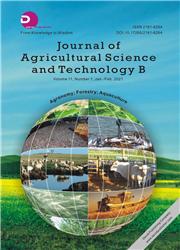Optimizing Fertilizer Use by Smallholder Farmers and Economic Returns to Maize in Semi-arid Niger
引用次数: 1
Abstract
Maize (Zea mays L.) is an important food crop in Niger, but low and irregular rainfall combined with sandy soils having low fertility level limit productivity. A two-year study was conducted at Institut National de Recherche Agronomique du Niger (INRAN) stations in Tarna/Maradi and Bengou/Gaya in 2014 and 2015 in order to evaluate maize agronomic and economic fertilizer use efficiency. The experimental design was a randomised complete block design (RCBD) with three replications. Results indicate higher effect of fertilizer in 2015 compared to 2014. At low N rates 20 kg N/ha and 40 kg N/ha, application of 20 kg P/ha increased maize grain yield across locations and years. The highest agronomic efficiency of N (AEN) was recorded with 60 kg N/ha in 2015 at Bengou and Tarna with 9.65 kg and 14.05 kg grain yield per kg of applied N, respectively. At Tarna, the low N rates of 20 kg N/ha and 40 kg N/ha recorded important AEN of more than 12 kg yield increases per kg of applied N. The highest rainfall use efficiency (RUE) of 6.13 kg/year/mm was obtained with application of 80 kg/ha N, 0 kg/ha P and 40 kg/ha N, 20 kg/ha P in 2015 at Tarna. Without P, the highest value cost ratio (VCR) value of 4.31 was recorded at Tarna in 2015 with 60 kg/ha N, and the lowest value of 0.08 at Bengou in 2014 with 20 kg/ha N. Based on VCR and RUE derived from this study, the optimal fertilizer recommendation for maize in the semi-arid conditions of Niger could be 40 kg/ha N, 20 kg/ha P and 0 kg/ha K.尼日尔半干旱地区小农户优化施肥与玉米经济效益
玉米(Zea mays L.)是尼日尔重要的粮食作物,但降雨少且不规律,加之肥力水平低的沙质土壤限制了产量。2014年和2015年,在尼日尔国家农学研究所(INRAN)位于塔尔纳/马拉迪和本古/加亚的站点开展了一项为期两年的研究,以评估玉米农学和经济肥料的利用效率。实验设计为随机完全区组设计(RCBD), 3个重复。结果表明,2015年施肥效果高于2014年。在低施氮量(20 kg N/ hm2和40 kg N/ hm2)条件下,施磷量(20 kg P/ hm2)在不同地点和年份均能提高玉米产量。2015年,本沟和塔尔纳氮素农艺效率最高,为60 kg N/ hm2,每kg施氮产量分别为9.65 kg和14.05 kg。在塔尔纳,低施氮量为20 kg N/ha和40 kg N/ha记录了重要的AEN,每千克施氮产量增加12 kg以上。2015年,塔尔纳施氮量为80 kg/ha、磷量为0 kg/ha和40 kg/ha氮量为20 kg/ha时,降雨量利用效率(RUE)最高,为6.13 kg/ mm /年。在不施磷的情况下,2015年在施氮60 kg/ha时,塔尔纳的价值成本比(VCR)最高,为4.31;2014年在施氮20 kg/ha时,本沟的价值成本比最低,为0.08。基于本研究得出的VCR和RUE,尼日尔半干旱条件下玉米的最佳施肥建议为N 40 kg/ha、P 20 kg/ha和K 0 kg/ha。
本文章由计算机程序翻译,如有差异,请以英文原文为准。
求助全文
约1分钟内获得全文
求助全文

 求助内容:
求助内容: 应助结果提醒方式:
应助结果提醒方式:


